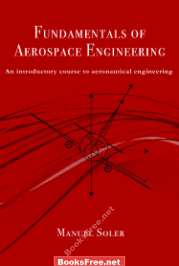| Book Name: | Fundamentals of Aerospace Engineering by Soler |
| Free Download: | Available |

| E-book Particulars : | |
|---|---|
| Language | English |
| Pages | 404 |
| Format | |
| Measurement | 12.4 MB |
Fundamentals of Aerospace Engineering by Soler
Author of Fundamentals of Aerospace Engineering
Manuel Soler obtained a Bachelor’s Diploma in Aeronautical and Aerospace Engineering (5-12 months B.Sc, 07), a Grasp’s diploma in Aerospace Science and Know-how (M.Sc, 11), each from the Universidad Politécnica de Madrid, and a Doctorate Diploma in Aerospace Engineering (Ph.D, 13) from the Universidad Rey Juan Carlos, Madrid.
He developed his early skilled profession in firms of the aeronautical sector. In 2008, he joined the Universidad Rey Juan Carlos, the place he was a lecturer within the space of aerospace engineering.
Since January 2014, Manuel Soler is Assistant Professor on the Universidad Carlos III de Madrid, the place he teaches undergraduate and graduate programs within the area of aerospace engineering and conducts analysis actions.
He has been a visiting scholar at ETH Zurich, Switzerland, and UC Berkeley, USA. His analysis pursuits concentrate on optimum management with utility to inexperienced trajectory planning for business plane in Air Visitors Administration (ATM).
Dr. Soler has participated in a number of analysis tasks and has printed his work in numerous worldwide journal and convention papers. He has been awarded with the SESAR younger scientist award 2013.
Fundamentals of Aerospace Engineering Contents
- Introduction
- The plane
- Air Transportation, Airports, and Air Navigation
- Appendixes
- Index
Preface to Fundamentals of Aerospace Engineering
Fundamentals of Aerospace Engineering covers an undergraduate, introductory course to aeronautical engineering and goals at combining principle and follow to offer a complete, thorough introduction to the fascinating, but advanced self-discipline of aerospace engineering.
This e-book is the ulterior consequence of three 12 months of educating a course referred to as Aerospace Engineering within the first 12 months of a level in aerospace engineering (with a minor in air navigation) on the Universidad Rey Juan Carlos, in Madrid, Spain.
After I began getting ready the course, again in 2010, I spotted there was not an appropriate text-book reference as a result of two basic causes:
First, the above talked about diploma was in english, a development that’s turning into increasingly in style in Spain now, but it surely was fully new at these days.
Due to this fact, the classical references utilized in related programs in Spain (introductory programs in aeronautical and aerospace engineering) have been written in Spanish.
Second, versus most components of the world, e.g., the USA and most of Europe, the place historically airports, air transportation, and air navigation are included within the department of civil or transportation engineering, the research of aeronautical and aerospace engineering in Spain (as a result of nationwide laws) embrace elements associated to airports, air transportation, and air navigation.
As a consequence, the classical references written in english and used as classical references in related programs didn’t cowl half of the contents of the course.
Due to this fact, I began writing my very own lecture notes: in english and protecting points associated to airports, air transportation, and air navigation. After three preliminary, draft variations used as reference lecture notes all through the previous years, they’ve developed into the e-book I’m presenting herein.
The e-book is split into three components, specifically: Introduction, The Plane, and Air Transportation, Airports, and Air Navigation.
The primary half is split in two chapters during which the scholar should obtain to know the essential parts of atmospheric flight (ISA and planetary references) and the know-how that apply to the aerospace sector, specifically with a particular comprehension of the weather of an plane.
The second half focuses on the plane and it’s divided in 5 chapters that introduce the scholar to plane aerodynamics (fluid mechanics, airfoils, wings, high-lift units), plane supplies and constructions, plane propulsion, plane devices and techniques, and atmospheric flight mechanics (performances and stability and management).
The third half is devoted to know the worldwide air transport system (protecting each regulatory and economical frameworks), the airports, and the worldwide air navigation system (its historical past, present standing, and future growth).
The theoretical contents are illustrated with figures and complemented with some issues/workouts. The issues deal, essentially, with aerodynamics and flight mechanics, and have been proposed in numerous exams.
The course is complemented by a sensible method. College students ought to be capable to apply theoretical information to resolve sensible circumstances utilizing tutorial (but in addition industrial) software program, reminiscent of MATLAB (now we’re shifting in the direction of open supply software program reminiscent of SciLab).
The course additionally features a collection of assignments to be accomplished individually or in teams.
These duties comprise an oral presentation, technical reviews, scientific papers, issues, and so on. The course is supplemented by scientific and industrial seminars, really useful readings, and a go to to an establishment or trade associated to the research and of curiosity to the scholars.
All this documentation isn’t explicitly within the e-book however may be accessed on-line on the e-book’s web site www.aerospaceengineering.es.
The slides of the course are additionally accessible on the e-book’s web site www.aerospaceengineering.es.
At this level, the reader ought to have seen that area engineering is sort of completely lacking. I’m afraid that is true. The course initially was geared toward offering an introduction to aeronautical engineering with the concentrate on business plane, and thus area autos, area techniques, area supplies, area operations, and/or orbital mechanics should not coated on this e-book.
Neither helicopters or unmanned air autos are coated. That is definitely one thing so as to add in future editions.
Download Fundamentals of Aerospace Engineering by Soler in PDF Format For Free.
Related More Books
See More POST On : Mechanical Books



